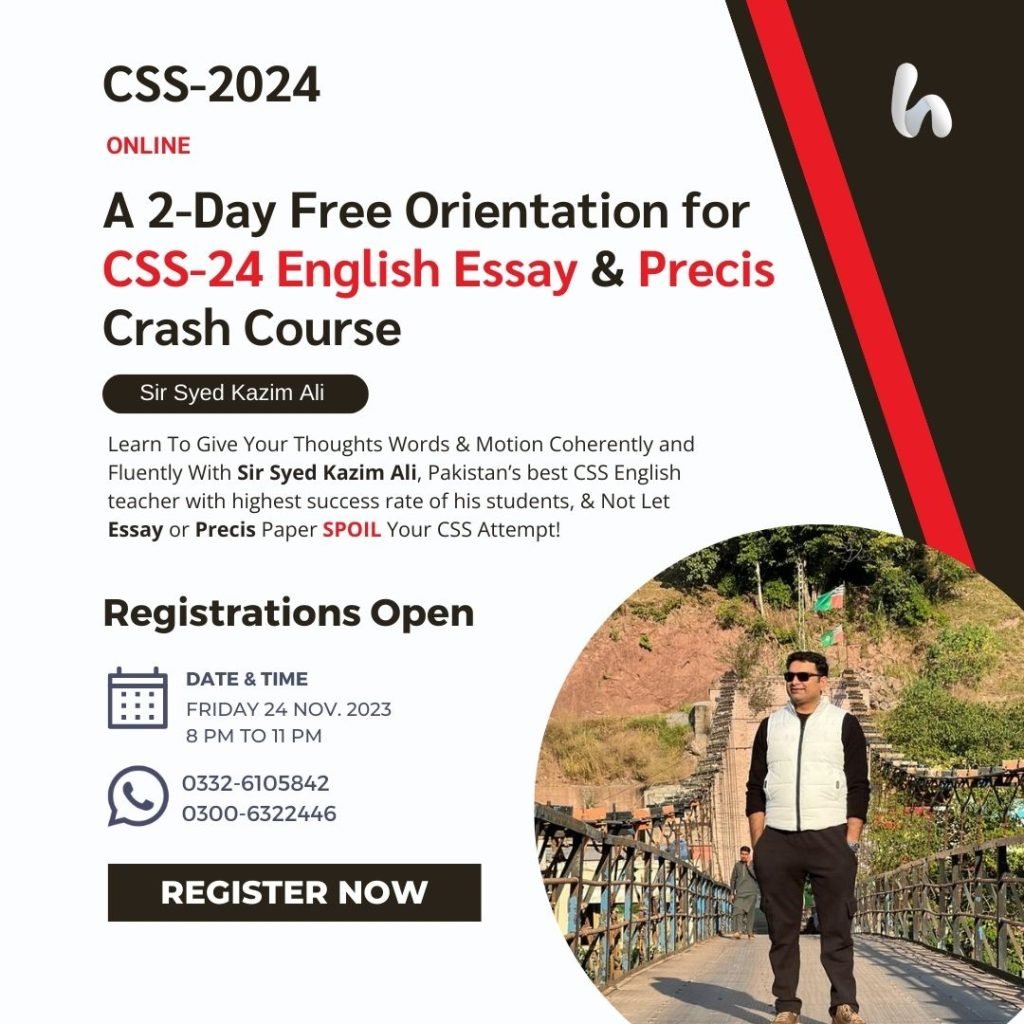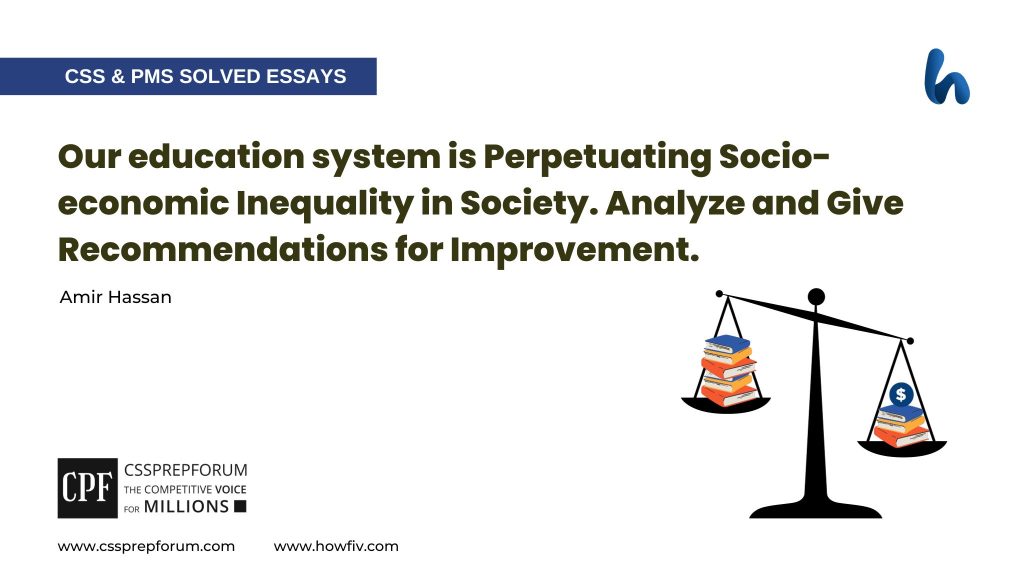CSS and PMS Solved Essays | Our education system is Perpetuating Socio-economic Inequality in Society. Analyze and Give Recommendations for Improvement.
Amir Hassan, a Sir Syed Kazim Ali student, has attempted the essay “Our education system is Perpetuating Socio-economic Inequality in Society. Analyze and Give Recommendations for Improvement.” on the given pattern which Sir Syed Kazim Ali teaches his students. Sir Syed Kazim Ali has been Pakistan’s top English writing and CSS, PMS essay and precis coach with the highest success rate of his students. The essay is uploaded to help other competitive aspirants learn and practice essay writing techniques and patterns to qualify for the essay paper.

Outline
1- Introduction
Pakistan’s education system—despite numerous reforms, has not carried out international standards to revamp the socio-economic status of people because non-uniformity in the syllabus, the erroneous training of teachers in public schools, and outdated pedagogical methods, along with an emphasis on cramming have made it harder for the low-income families to cope with the demands of day to day raising competitiveness worldwide. Hence, taking robust initiatives to ride the storm of the crises is the need of the hour for the nation.
2- Broad overview of the existing education systems of Pakistan
3- How does Pakistan’s learning pattern perpetuate socio-economic inequality in the society?
- ✓ Non-uniformity in private and public institutions making it harder for poor students to get job opportunities
- Case in point: Oxford and Cambridge education models versus more than 23-year-old syllabus in public institutions
- ✓Shrink of proper training among teachers bolstering incompetency in students
- Case in point: Minimum degree of fourteen years of education, such as a Bachelor of Arts (BA) or sixteen years of education in any field, according to the Punjab Education Department (PED)
- ✓Improper sanitation in education institutions, surging dropout ratio of children
- Case in point: Poor sanitation, like drinking water, washrooms, and clean areas in public sectors in Pakistan, UNICEF
- ✓Outdated pedagogical structure with cramming methodology, making students lack critical thinking
- Case in point: cramming notoriously causing stress, anxiety, and mental issues, a report by Universitas Kristen Indonesia (UKI)
- ✓Only seminaries coaching system depriving students of modern knowledge of science and technology
- Case in point: around 2.6 million students enrolment in madrassahs in Pakistan, according to a study conducted by the Ministry of Federal Education and Professional Training (MFEPT)
- ✓Less availability of scholarships for poor families magnifying the social evils like child labour
- Case in point: 13.7 per cent of children aged 10-17 years as being engaged in child labour—International Labor Organization (ILO)
- ✓Scarcity of availability of separate education institutions for boys and girls making it hard for conservative rural families to send their girl child to schools
- Case in point: Ten boys versus four girls enrollment in education sectors in Pakistan—a report by the United Nations (UN)
- ✓Lack of unsuited checks and balances on the budget allocation of education sectors, creating the worst condition for education institutions
- Case in point: spending about Rs1,000 billion on education annually next to defence and debt serving budget—Miftah Ismail—former minister of finance Pakistan
4- How has the elite captured a controlled education system, making it impossible to achieve socio-economic equality?
- ✓Construction of expensive academies without proper mentors by academy mafias
- ✓Political alliances of elite mafias for altering education reforms
5- Practical recommendations for making the nation’s education system effective and efficient for the nation-building
- ✓To bring in vocational training for teachers as well as students
- ✓To encourage national and international language among college students
- ✓To grant scholarships to poor families from the primary level
- ✓To set up a uniform education model of science and technology
6- Critical analysis
7- Conclusion

A worthwhile education system leaves no stone untouched for the progress and prosperity of a nation at national and international levels. Undoubtedly, people in a country with skill and quality education have been enjoying all the luxuries of socioeconomic standards and personating critical roles in nation-building. The glaring examples in the context are the United States, Japan, China, and most of the European states. Today, poor nations like Somalia, Nigeria, and Pakistan, having a blind eye over the fourth strongest pillar of Sustainable Development Goals (SDGs)—education, have been dancing to the tunes of the dominant economies for some financial assistance. Although Pakistan has brought forward various education reforms to cope with the demands of modern education standards for the betterment of citizens’ living standards, the education mafias have destroyed the structural progress of public institutions, making the nation’s education model rich-centric. In addition, non-uniformity in the curriculum has sincerely closed the doors of employability for students having attained a medium of learning other than English. Not to speak of this, less availability of scholarships since primary education has coerced poor families to send their children for child labour. Due to this, the Global Competitiveness Index (GCI) has ranked Pakistan 129th out of 137 states worldwide. Nonetheless, the situation has not been set up overnight; factors like rampant corruption and an alarming dropout ratio have fueled the burning flames of the country’s chaotic education system. Now, the state is at a crossroads; therefore, maximum vocational training programs for teachers and students and the introduction of a uniform education system in science and technology must be the nation’s priority.

Before illustrating how education is perpetuating socioeconomic inequality, it is imperative to have a broad overview of Pakistan’s various education systems. There are three mediums of education in Pakistan. From the top of the list of Article 25-A, Part-II, Chapter 1 of the Constitution of the Islamic Republic of Pakistan ensures the right of individuals to acquire free and compulsory education for children aged 5 to 16. Apart from the public sector, the private sector—institutions that charge parents of students for education have been raised at an unprecedented pace. Lastly, the madrassah education model, where religious education is provided along with free food and shelter to the seminaries. In a nutshell, all these education systems have substantially played an important role in shaping the socioeconomic standards of the nation.
Now, coming towards proving that Pakistan’s education is perpetuating socioeconomic inequalities, the uniform education model has created several hurdles for poor people. The system itself has a discriminatory approach because it creates two models of education. One is the English model of education—mostly Oxford and Cambridge, and another is the public model with regional language and outdated material, an almost 23-year-old method. This, as a result, has deeply impacted the employability ratio of the youth in the nation as elite schooling provides a command of the English medium, and students of this institution create a greater impression during their job interviews. On the other hand, graduates from public institutions remain deprived of job opportunities, making socioeconomic inequality visible to all.
Next to it, the quality of teachers’ education is a deep matter of concern as teachers are considered to be the basic building block for the foundation of students’ careers. However, becoming a teacher at primary and junior levels is a minimum requirement in Pakistan; he or she must have fourteen years of education, such as a Bachelor of Arts (BA), or sixteen years of education in any field, according to the Punjab Education Department (PED). Ultimately, students in these institutions gain less due to the incompetence and lack of experience of these teachers. Subsequently, students become incompetent at national and international levels, making it difficult for them to gain economic opportunities in their coming years.
Not to speak of this, but a clean and properly hygienic environment is a basic requirement that every student has in their nation. However, in the case of Pakistan, according to the United Nations International Child Emergency Fund (UNICEF), poor sanitation, like drinking water, washrooms, and clean areas in public sectors, has coerced families to resist their children from attaining classes. As a result, the nation has been witnessing a massive dropout ratio every coming year.
Additionally, outdated pedagogical methodology has created massive gaps between students in Pakistan and students at global levels. All this has happened because outdated pedagogical structure with cramming methodology has made students lack critical thinking. Moreover, cramming notoriously has been the reason for stress, anxiety, and mental issues, according to a report by Universitas Kristen Indonesia (UKI). In short, the world has moved towards modernized and artificial intelligence-based learning mechanisms, and people in Pakistan are still following traditional learning mechanisms, putting the nation backwards.
Fifth, the Madrassah education system provides only religious knowledge to the seminaries. However, they remain deprived of modern knowledge of science and technology; therefore, they do not have the maximum job opportunities at national as well as international levels. Around 2.6 million students enrol in madrassahs in Pakistan; a study conducted by the Ministry of Federal Education and Professional Training (MFEPT) highlights that with religious knowledge and scientific knowledge, they improve their socioeconomic statistics. But, unfortunately, this seems to be a distant dream as far as the current education model is concerned.
Besides this, less availability of scholarships for poor families has promoted social evils like child labour. The rich enjoy all luxuries in society they can afford, including stationaries, books, and uniforms; however, due to their poor circumstances, children are forced to leave their schools and pushed into child labour. According to the International Labor Organization (ILO), 13.7 per cent of children aged 10-17 years have been engaged in child labour. Subsequently proving our education system’s socioeconomic inequality for the poor.
Further, the lack of availability of separate education institutions has made it harder for conservative rural families to send their girl child to schools. In most of the rural areas of Pakistan, female education has not been given the same importance as male education. Moreover, most of the families there do not send their girl children to educational institutions because they are against the co-education system. As Pakistan lacks separate schools for these girls, it has created a drastic difference in the education of girls and boys nationwide. A report published by the United Nations (UN) has highlighted that a ten-boys-versus-four-girls enrollment ratio has been found in the education sector in Pakistan. Consequently, this has created fewer job opportunities for female members of society.
Last but not least, the lack of proper checks and balances on the budget allocation of education sectors has caused the worst condition of education institutions. Although Pakistan’s budget allocation for education institutions is small when compared with other nations, the main issue of utilizing the budget has been ignored for years. For many economists, like Miftah Ismail, a former minister of finance in Pakistan, Pakistan spends about Rs1,000 billion on education annually, next to defence and debt-serving budgets. Thus, the nation’s poor management policies have created massive socioeconomic disparities.
Unquestionably, education mafias have controlled the education system of Pakistan. In reality, they have made education a source of income for their business. Yearly, millions of rupees have been earned by the various institutions, making it harder for the public sector to sustain for the betterment of people living in the nation. According to the Higher Education Commission (HEC), private institutions hold only thirty-one per cent of overall education institutions in Pakistan, but they have created a greater impact on the socioeconomic inequalities statewide.
Parallel to this, such mafia groups have greater influence over some corrupt political leaders. According to the Corruption Perception Index (CPI) report 2022, Pakistan has ranked 140 out of 180 states worldwide. Moreover, the mafia gang has raised their influence in such a way that it can alter any policy or decision that can favour national unity. Thus, the government could take any initiative that can lead the nation toward the era of economic equality.
All is not lost yet; the nation can improve its education model as per international standards. For this, the top priority of the nation must be the introduction of vocational training for both teachers and students. For example, the state has taken numerous initiatives under the National Vocational & Technical Training Commission (NAVTIC). Now, there is an urgent need for such programs so that people can get highly qualified skills for acquiring job opportunities in any field of expertise. Hence, Quaid Azam Muhammad Ali Jinnah has highlighted that the magnificent goals of the education sector will be to develop the character of Pakistan, a high sense of responsibility, social integrity, selfless service to the nation and morality on the part of the people of Pakistan.
Additionally, the state must promote other foreign languages during students’ college days. In most countries, like China, Russia, and Japan, one national language is the most important factor that they have never compromised. Any student going for higher education there faces a lot of problems in communication. However, the Indian curriculum allows students to take any two foreign languages, such as Spanish and French; in this way, they should get maximum job opportunities in these countries because they have good communication skills.
Further, in Pakistan, poverty has created miserable socioeconomic problems. Parents here cannot afford to pay for the education of their children. If they do so, they have to sacrifice one-time food for their family, forcing them to do child labour. In this regard, the government of Pakistan must introduce maximum scholarships in most of the rural areas, especially for girls, as they are deprived members of society. Scholarships that contain free uniform stationaries can help the nation to construct a robust nationhood in the long run.
Lastly, introducing a uniform education model can help the nation to achieve socioeconomic equality. Unfortunately, the implementation of a Single National Curriculum (SNC) has not gained recognition from provincial autonomies as it had no clear indications for the minorities and other literature and linguistics for all ethnic groups living nationwide. Therefore, the implementation of reform was not successful. In addition to this, the government must focus on the introduction of a uniform model of education with modern scientific and updated material. In this way, the education mafia business should get a lot of damage, causing them to stop discriminating education standards for the poor and the rich.
In a nutshell, the existing education system of the nation has deep flows to achieve socioeconomic equality. Not to speak this, multi-milliner business tycoons have controlled the education sectors in Pakistan, making it impossible for the poor to get the maximum number of jobs. Apart from this, they have maintained greater influence in political decision-making power. Whenever an education policy is introduced nationwide to ensure quality education for all citizens, they take all illegal means to alter the decisions of the government institutions. Hence, the rich can afford the expenditures and have greater opportunities to acquire job opportunities due to their peer knowledge of science and technology. Therefore, to gain an equitable society, the nation must introduce vocational training for both teachers and students and introduce a single national curriculum of science and technology for the private, public, and madrassah education systems. As Quaid Azam Muhammad Ali Jinnah aptly stated, education is a matter of life and death for Pakistan. The world is progressing so rapidly that without requisite advances in education, not only shall we lag behind others, but we maybe wiped out altogether.

CSS Solved Past Papers’ Essays
Looking for the last ten years of CSS and PMS Solved Essays and want to know how Sir Kazim’s students write and score the highest marks in the essays’ papers? Then, click on the CSS Solved Essays to start reading them.
CSS Solved Essays
CSS Solved General Science & Ability Past Papers
Want to read the last ten years’ General Science & Ability Solved Past Papers to learn how to attempt them and to score high? Let’s click on the link below to read them all freely. All past papers have been solved by Miss Iqra Ali & Dr Nishat Baloch, Pakistan’s top CSS GSA coach having the highest score of their students. General Science & Ability Solved Past Papers
Articles Might Interest You!
The following are some of the most important articles for CSS and PMS aspirants. Click on any to start reading.












